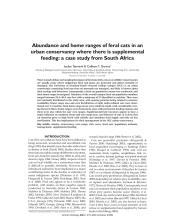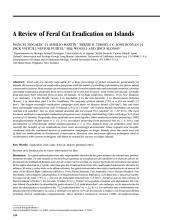Abundance and Home ranges of Feral Cats in an Urban Conservancy where there is Supplemental Feeding: a case study from South Africa


Island and Ocean Ecosystems, BRB
Available Online
Downs, C.T.
,
Tennent, J.
2008
There is much debate surrounding the impact of feral cats (Felis catus) on wildlife. Conservancies areusually areas where indigenous flora and fauna are protected and aliens excluded or managed. The University of KwaZulu-Natal’s Howard College campus (HCC) is an urban conservancy containing feral cats that are presently not managed, and little is known about their ecology and behaviour. Consequently a feral cat population census was conducted, and their home range investigated. Estimates of the overall campus feral cat population numbers ranged between 23.4–40.0 cats/km2 with a minimum of 55 identified as resident. They were not randomly distributed in the study area, with spacing patterns being related to resource availability. Home range area and core distribution of eight radio-collared cats were determined over 13 months. Total home range areas were relatively small, with considerable overlap between them. Home ranges were clustered in areas with permanent feeding stations and these were also within the cats’ core ranges. Supplemental food resources appear to have a major influence on numbers, home and core range area, and behavior of cats. It is clear that cat densities grow to high levels with reliable and abundant food supply and only ad hoc sterilization. This has implications for their management in the HCC urban conservancy.


